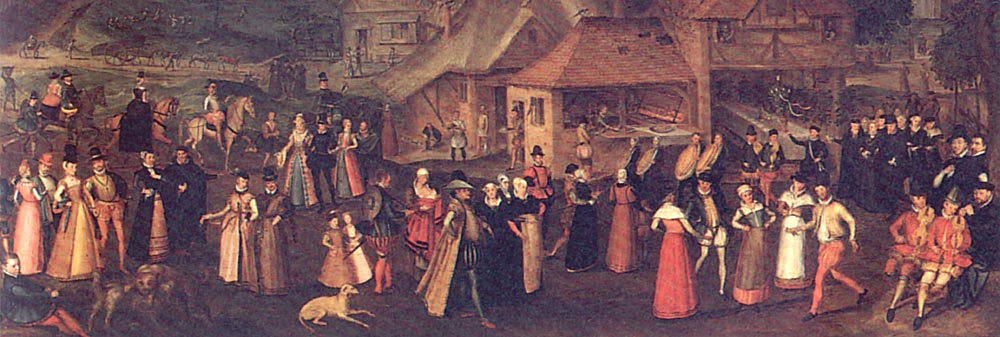
A Fete at Bermondsey, Detail
Fabric Color Myths
Myth: Colors for the less well to do were drab & boring. Black colored garments were reserved for the nobles only.
Colors of the time were all over the natural dye spectrum. Green Copperas or Green Vitriol (aka Iron sulphate) was used in the natural dyeing process, not only as a mordant but also to 'sadden' the colours. Another mordant, alum, which provides for bright clear colors, was unavailable in England during much of the English Tudor period due to political issues, but could be found on imported dyed fabrics.
Black fabrics are of two types; dyed fabrics, including silk, and undyed naturally dark colored wool. Dyed black fabric, especially silk, is dyed using expensive materials, possibly dyed twice or three times, and may fade over time, or worse, rot away. Hence black dyes were expensive and often only nobles or those with some money to spare could afford it. And while good deep black is often used by courtiers, it was not the only color they wore, as found in reading their wills, gift rolls, and tailors accounts.
Undyed dark brown or black wool is inexpensive and was more easily available for common folk, but not as impressive or rich in color. Many people of all levels wore as "best" clothes black garments, because it can hide dirt easier.
A Fete at Bermondsey by Joris Hoefnagel, 1569-70
Also view The Peasant's Dance, and Peasant Wedding, both by Pieter Bruegel.
Info on colors, dyeing, and black wool from several sources, including:
- an article from Elizabethan Hand Dyed Embroidery Thread Range.
- Sim, Alison. Pleasures & Pastimes in Tudor England, ©1999. Sutton Publishing Ltd, Great Britain. ISBN 0750931779